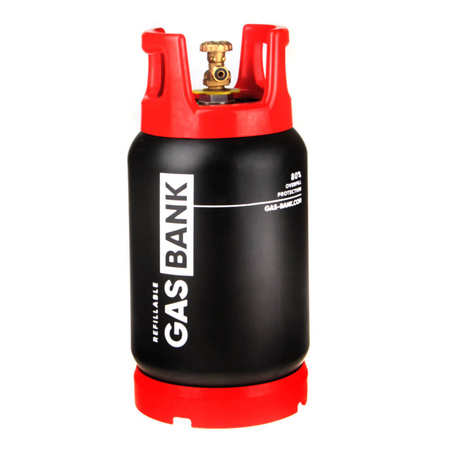Refit year 13 (2024-25)
13th refit and 6th winter in Marina Coruña, Spain
Polished and extra hard waxed hull
As in every year, Regina Laska's hull is being polished and waxed. New for 2025 is that Regina Laska will get an extra layer of hard wax for extra protection.
Look below how shiny she is, even before she is being touched by Ruben at Marina Coruña! The photo was taken in October 2024, just after she went into the shed, still hanging in the slings of the travel lift.
This shine is still from last winter's treatment. Incredible, how shiny she is, even after 6 months of intense sailing. When a great ground work has been done, it lasts a full season!

Regina Laska just entered the shed for the winter for her boat Spa season.
Re-activating Coppercoat
The hull is being sanded to a minimum to re-activate the Coppercoat.

Checking "Fred's Smile"
With an external lead keel, there is sometimes some water seen between the lead and the GRP. This is a very frequent reason for uncertainty and may boat owners immediately fear their boat is leaking doe to loose keel bolts. This is not only the case for HR boats but any boat with external lead keel. I have seen it on various very well built Sirius boats as well, for instance.
After a very hard hit against a stone, this could well be the case and it must definitely be checked and repaired. But if you haven't hit the ground, this is most probably just "Fred's Smile" (who ever "Fred" was... I have no clue!). I am always happy when fellow boat owners take out their tanks and have their keel bolts checked and then revert and say that all is in best order. Since then, I don't have to do this costly check.
From time to time, the flexible (no epoxy, please!) sealant between keel and GRP needs to be replaced. In my case, they took out the sealant layer by layer and checked it and found that just the outer layers were wet and the interior was still dry. See my full story on "Fred's Smile" under FAQ.
New pressure tank
After 12 years, it's time for the preventive measure to just replace the pressure tank. It's a rubber membrane inside which gets brittle over time. I'm surprised it has worked so well for so long!

"Colonoscopy"
The never-ending issue with sailing in warm, salty water is growth inside the through-hulls. Especially when you have a strainer under the hull and can't reach inside with a brush to clear it out while snorkling or diving.
On the hard is a good opportunity to use my "Colonoscopy Camera" (Inspection Camera with a snake cable connected to my iPhone).


Using the camera to look inside a through-hull from above. This is doable when there is a straining immediately on top of the through-hull. Other through-hulls can only be inspected from below.
Some through-hulls have a scope mounted over the hole from the outside. This strainer is to prevent large things like plastic bags or jelly fish to enter the boat and also to help pushing the water up if mounted forward, like for the watermaker. The main engine raw-water intake has its scope facing aft, however, not to flood the engine while sailing! N.B. Powerboats, which don't move without the engine running, have the scoop facing forward. This is an important difference not to neglect our your engine may be flooded!
Both through-hulls cannot be cleaned from the outside unless the scoop is screwed off, unfortunately.

Ruben is opening up the forward pointing scoop for the watermaker intake to free it up from mussels that get in and then grow big inside and eventually get stuck, so they can't get out!
.
Taking off the scoop and to look inside does give some surprises: miniature animals have been sucked into the through-hull and then they grow inside - on the wrong side of the bars! Winnie-the-Pooh, eating honey, remember?
.

Winnie-the-Pooh got stuck by eating too much honey on the inside and couldn't get out. Same with my mussels in the fridge water / watermaker intake!
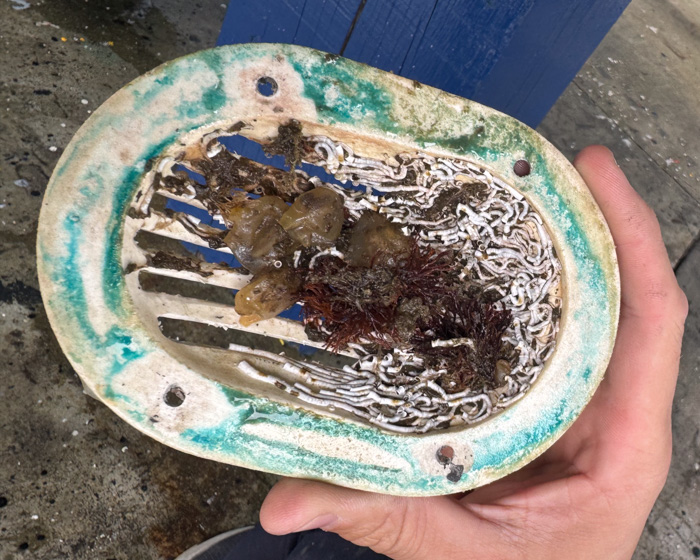
This how it looks on the inside of the strainer! Winnie-the-Pooh on Regina Laska!
.
Of course, the water intake is getting blocked. The same strainer as seen from the inside:

.
Below examples of other photos of the through-hulls. Some surprisingly clean, especially the ones leading water outside back into the sea or taking in water in larger quantities but not continuously (like the main engine or the generator were both clean).

Click here or on the small picture below if you wish to see the results of the colonoscopy:
Moving the raw water intake for fridge & freezer
There are various ways to cool the fridge and freezer compressors. The most basic design is simply to let the air around the compressor cool them (not very efficient). They you have internal heat exchangers where the cooling liquid is led along the hull on the inside hoping that the cooler water on the outside cools it. This works well on metal boats but on isolated GRP hulls, this is not very efficient wither. The third option is to lead the cooling liquid to a heat exchanger inside a through-hull so it actually exchanges the heat directly with the water standing inside the through-hull. This is a smart system by Isotherm. The down side is that it is only efficient when the boat is moving (even a slight movement while sailing on the anchor is enough), since the water standing inside the though hull gets warm and needs to be exchanged. In a marina, for instance, when the water is standing still, this system is less effective, but, on the other hand, that's when you mostly have shore power compensating for the loss of efficiency. What I also don't like with this, otherwise very smart system, is that the through-hull used is made of brass.
Most effective is, instead, to pump raw-water from the sea and lead it around the compressors and then pump the heated water overboard again. While this saves energy and cools efficiently, the downside is that you constantly pump seawater into the boat which is a risk of flooding, of course. Further, the compressors can't run dry on the land and always need to be cooled with seawater. So when I leave the boat for anything more than a couple of hours, I try to empty the fridge and freezer content and then switch off the fridge/freezer completely and close the through-hulls. Since I live onboard for extended periods, this is a minor problem and I have decided to go for the most efficient cooling system.
So, constantly, water is slowly pumped inside the boat. 24/7 whenever the compressors are running. This has one further draw-back: the constant water intake means that miniature sea-life, such as hardly visible baby mussels, are continuously pumped inside and then they get stuck in various strainers, filters, hoses and in the pump itself! Regular filter cleaning becomes necessary, but for me, it's worth the price since they cool very efficiently.
.

This is the fine filter that sits close to the fridge/freezer water pumps and needs to be cleaned weekly in some waters, while very seldom when sailing on the blue Atlantic Ocean.

The fine filter in line of the raw water intake. In the background the pumps and compressors for fridge and freezer under the floorboards.
.
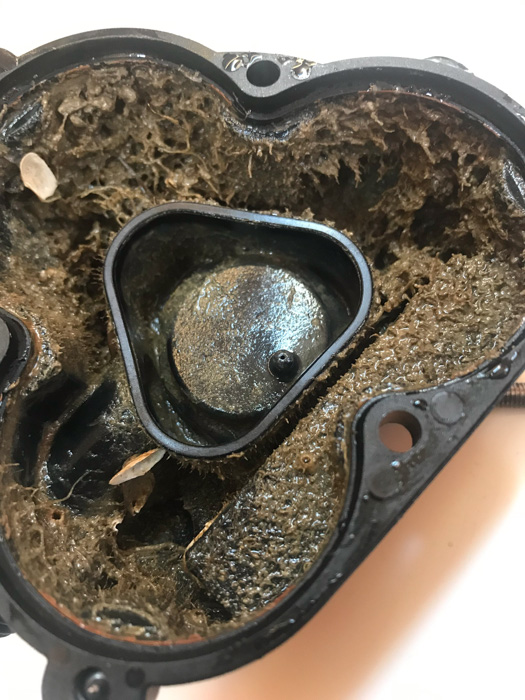
This is how the water pump looks after one season if you have no fine strainer installed. Back in Sweden, this fouling was less of a problem, so this was taken after my first season in the south before I had installed a fine-filter before the pump.
.

This is how the hose looks like leading raw cooling water to the pumps. It has been sitting with no movement over one winter. During this time, the miniature creatures have grown into larger mussels. There must therefore be no water left with baby mussels that can grow inside the hose, even with no moving water and complete darkness during winters. Nature is amazing!
.

Therefore, during each winter, it's important to disconnect the fine filter (easily done with fast connectors) and press out remaining water with pressurised air. A couple of puffs and no water left with any wildlife in the hoses over winter. Or, that's the idea, at least...!
.
Due to the above problem with fouling I have decided to move the intake of the cooling water.
I have come to the conclusion that it's not a good idea to have a scoop for the fridge water-intake due to the fact that it is sucking in water 24/7. I know by experience - the hard way...
So instead of having the fridge water sharing the through-hull with the watermaker (which must have a scoop pointing forward), I will now share the fridge water intake with the generator (which shall not have a scoop, for whatever reason. It says so in the manual by Onan).
With no scoop, I can easily clean this intake when snorkling or diving from underneath. Orin in best case, creatures getting into the through-hull will then fall back outside whenever the pumps are stopped. Let's hope it gets better. Can't get any worse, at least....

Today and future sharing of through-hulls.
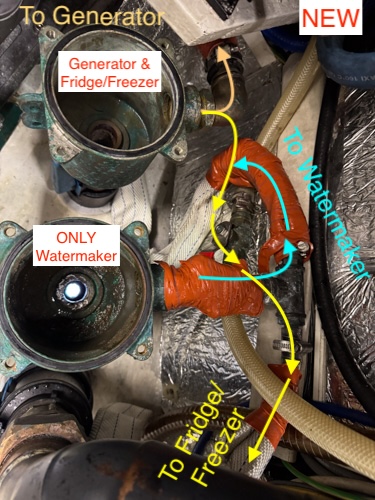
Outboard
It's time for a major overhaul of my 4 year old Yamaha outboard. It ranges from standard service to exchanging some bolts and nuts that got rusty and cosmetically doesn't look so smart any longer.

Abel taking care of Regina Laska's outboard engine
New AB Dinghy
Our highly versatile and popular Caribe 9L dinghy is replaced by an AB dinghy that is officially approved for 5 people. Taking four guests, I need the approval for five, hence the upgrade.
Therefore, our current, still perfect Caribe dinghy is up for sale. Great for anyone passing by La Coruña on the way to the Med or the Caribbean.
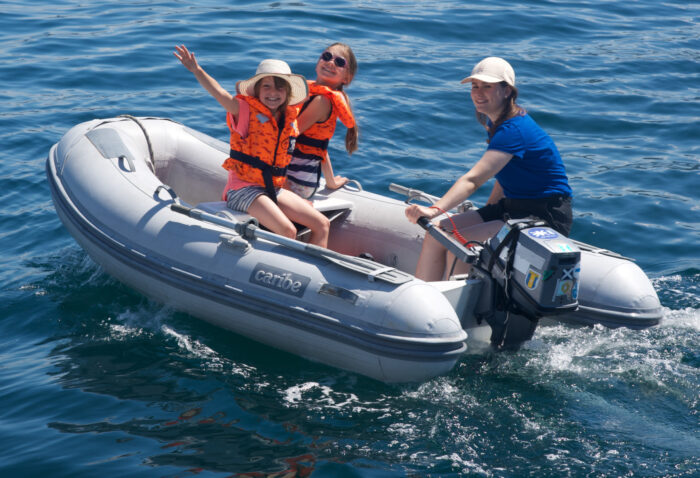
Our old dinghy, now for sale.
.
The new dinghy is the AB 9.5 ALS aluminium RIB with unpainted aluminium hull for the extra sturdiness. It was also ordered with a built in little bow locker for life jackets, anchor, NaviSafe lights etc. It was specified in co-operation with BootAkkrum in The Netherlands and built by AB in Colombia.
See the AB 9.5ALS offered by BootAkkrum here.
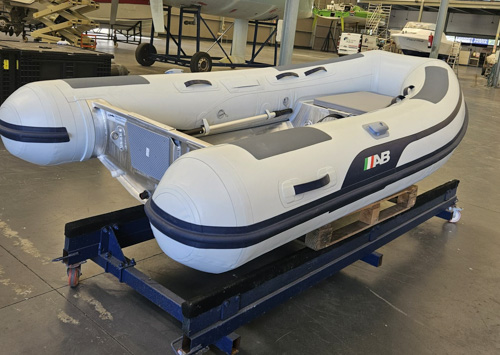
The new AB Dinghy as seen for the first time as it was shipped to Marina Coruña.
.
The service by Jan-Jetze van der Meulen at BootAkkrum has been outstanding and we got our dinghy in time with a lot of special requests. It's colour is "arctic grey" with "ocean blue" rubrail, which is not standard (see photo above).

Before delivery: comparing our Caribe Dinghy (left) with the AB 9.5 ALS of my sailing guests Christel and Achim Schindler sailing their HR43 Becky (right). Similar in size, the AB dinghy is approved for one more person (and yes, our dinghy needs a wash!).
.

Tito giving our dinghy the annual spa treatment at Marina Coruña. Next spring, hopefully, it will be used by a new happy owner.

The specs of our new dinghy are shown below:
- The bottom of the keel has a Gatorguard KeelShield protection.
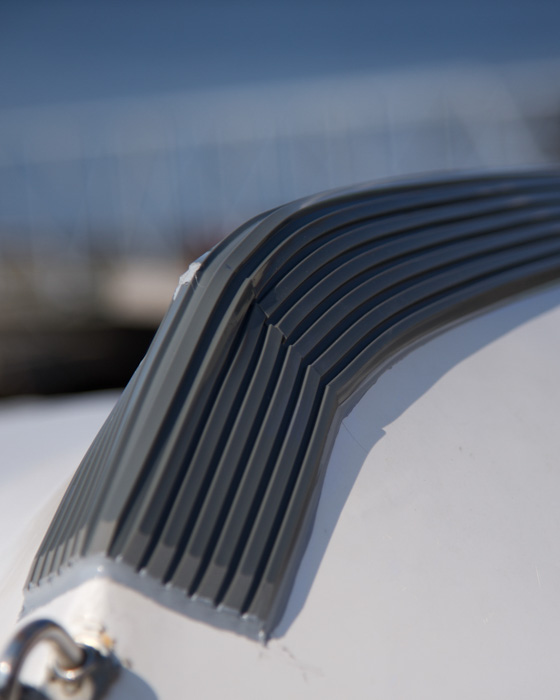
The keel protector as seen on our old Caribe Dingy.
- It has reinforced anti-slip top for comfortable and safe sitting without sliding around. Thse anti-slip toppings are also good when locking the dinghy against the davits.
- The davits have soft cushions for anti-chafing by Palm that are originally intended when transporting surfboard etc on a car roof. Works perfect on a davit.

The anti-chafe protections by De Palm.
- Special extra eyes are welded onto the aluminium hull from the inside for better lifting in the davits as well as for placing a chain with pad lock.

Some extra eyes were welded into the aluminium, both for ideal lifting points for the davits as well as for anti-theft security. The Abus-Lock fits snug into the eye and both are very difficult to break.
- Prepared for Båtsystem RIB ladder
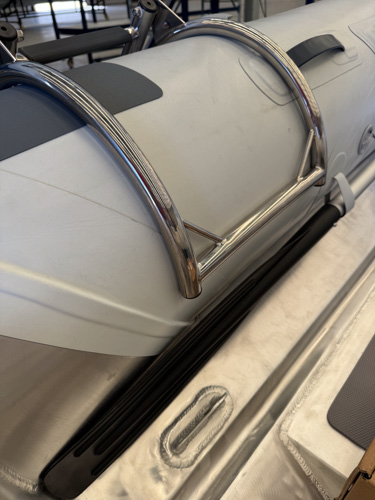
The extra lifting eyes as seen under the RIB-ladder. The RIB ladder is connected to one of the lifting eyes on one side. On the other side there is a Boatsystem eye to be fitted onto the aluminum hull.



Testing the Båtsystem RIB-ladder in Marina Coruña.

- Wheels facilitate moving the dinghy onshore, especially on a ramp or beach in tidal waters, where the dinghy needs to be pulled up quite significantly
The dinghy is getting Beachmaster retractable wheels, which are said to be the most sturdy ones. The New Zealand company didn't answer neither telephone calls nor e-mails but in the end I dared to order without speaking to them, nevertheless. Guess my surprise when 5 working days later they had arrived from New Zealand to Marina Coruña.

Beachmaster as seen on their website.
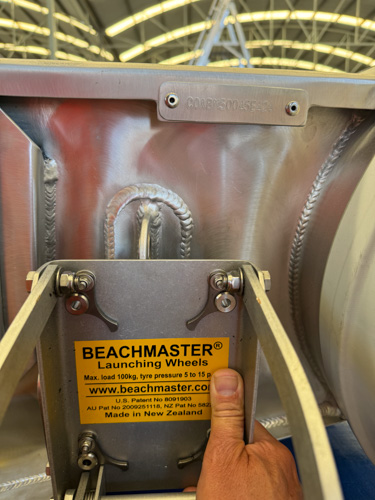
The idea with the Beachmaster wheels came late and after ordering the dinghy at boot Düsseldorf 2024. So we unfortunately have to get rid of the stern eyes on the transom to find place for the wheels. There are similar eyes on the inside of the transom so we shouldn't need these ones pointing aft, anyway.
- The weelmark approved Navisafe navigation lights are again installed on the new dinghy.

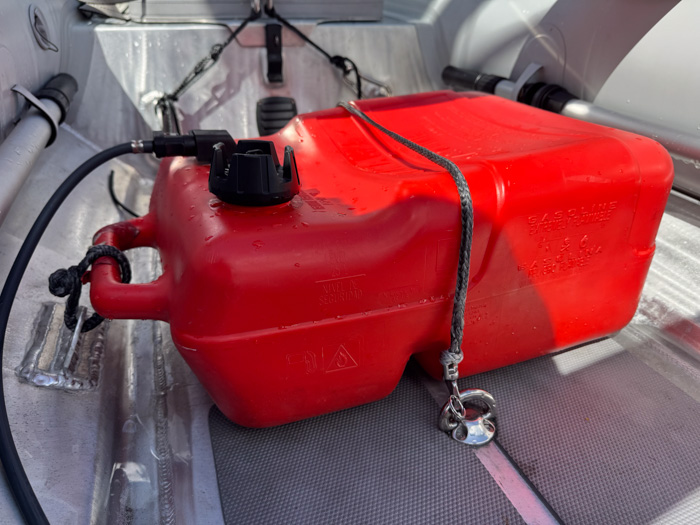
The tank is held i place in three points with extra rings fitted. It's placed under the bench with enough legroom for the forward and rear passangers. The bow locker is reserved for ropes, NaviSafe navigation lights and life jackets when going ashore.

The Dinghy is named including its individual e-mail number, in case someone "borrows" the dinghy and it is later found. The name of the dinghy is individual ("Miranda" Rather than "T/T Regina Laska") so people ashore would not assume that the main boat is inhabited if the dinghy belonging to her is seen ashore (T/T = Tender To)

The dinghy is so nice, so I added some DanFenders to them. They are so small and sweet but will avoid scrapping against a pier full of shellfish and mussels.
In the davit
The new AB dinghy has a bow locker, which is very handy to store stuff. For this reason, the bow lifting arrangement had to be built in order to allow for a lifting point exactly above the hatch. It should be easy to take off and yet be fitted in a sturdy way so that the dinghy could be lifted high enough for the friction batches to touch and lock against the davits. For this, extra short hooks were needed, which I found from Wichard (Part No 2293).
In the stern, I use two lifting points so that the dinghy remains horizontal during lifting. Lines are Dyneema.
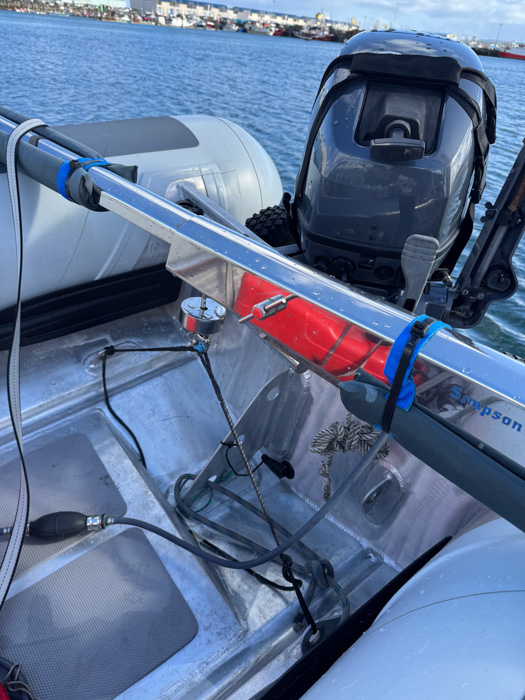
Stern lifting point using two specially welded eyes (custom made by AB for me to fit the outboard outside the dinghy davits)

3-point lifting arm in order to get the lifting point at the correct place. The forward eye is connected to the hull inside the bow locker, since the locker itself is just loosely welded into the dinghy and can not take any load. Lines are made of Dyneema.

Reinforcement inside the bow locker to take the load from the aluminium hull rather than from the top of the bow locker.

The various extra eyes. These are intended to be used when hoisting with engine. The extra forward one on the starboard side is for holding the Båtsystem RIB ladder.

The extra short hooks to go the extra mile to hoist to the max in order for the tubes locking against the davits.

The grey friction-patches with extra high friction were placed by AB. They give a secure feeling while sitting on the sides and lock nicely against the davits.
New Gas hoses and bottles
As a standard procedure for a commercially classed vessel, I have to undergo regular inspections and replacements. All Safety equipment needs to be sent in for inspection annually and the gas hoses need to be changed ever 4 years. So, it's time again....

After 10 years of service life, it also time to exchange the Swedish aluminium PA6 gas cylinder holding 6kg of Propane.
I normally store two Butan Camping Gaz 907 (2.8 kg) on top of each other for sailing in the EU and use the Propane bottle when I leave the EU, e.g. to the Azores. Here, filling a Propane bottle is the best option. When I sail away from Europe for a longer time, I would carry two non-rusting gas bottles. See more about gas onboard Regina Laska here.
Which bottles shall I buy to replace the discontinued Swedish PA6? Most bottles have a 300mm diameter, but they don't fit into the gas compartment! I am sure Hallberg-Rassy once designed the gas hatch to fit exactly these PA6 bottles. The bottle is 250mm (diam) x 500mm (hight). But as times go by, the standards change and the classic boats remain.
Most Propane bottles seem to have a diameter of 300m these days, e.g. the aluminium bottles by Alugas or BBQ-Master, which is actually made by the same company. And gas cylinders made out of composite also have a diameter of 300mm which, for a classic HR, is too wide to fit thought the hatch (it would fit inside, however).

I am now looking at a 5.4 kg Propane bottle made out of AISI 316 stainless steel by a Dutch company called JSP Europe. It has a diameter of 229 mm and a hight of 487 mm and should fit well into the compartment.

Another alternative would be the composite bottles made of Kevlar by Polish Gas Bank. That's the bottle I bought in the end, since the one from JSP is still not available in AISI316 steel but only AISI304.
I bought it from the LPG-Shop in the UK and had it shipped to Jersey where I will be sailing to later this spring.
A third alternative that fits would be to continue with Aluminium, and here I have identified a company in Budapest, Hungary called ALUMÍNIUMÁRUGYÁR ZRT that produces a 6kg bottle that fits in size.
More info to follow in due course.
Volvo Penta Service
As a preventive measure, the thermostat is being changed and the heat exchanger cleaned and the internal cooling water changed. The turbo is inspected and so is the elbow for the exhaust water/gas mixture.
The isolation cover over the turbo is changed manly due to cosmetic reasons, but also to avoid burns, of course.


Cleaning cooling system
I noticed when I was driving hard with the engine on full throttle that the temperature was rising over 100°C which is not normal. The first suspect is the gearbox cooler, where the raw water goes through first. It was rather blocked with sea weed and small mussles that fit through the Vetus strainer and then grows inside. Similar to the fridge problem.

It's a very good practice to open up the cooling system every couple of years and look inside. Here: the gear cooler where the raw waters enters first on its way around the engine.
The entrance to the main heat exchanger. Not too bad, but clearly worth clearing up the blocked holes.

The cooling system in parts in the workshop for an overhaul. I like keeping my engine in perfect condition!
Cleaning turbo and elbow
The turbo and elbow need to be checked regularly, maybe every second year. Both needed some cleaning but otherwise they were in good condition and did not need to be exchanged. The elbow was exchanged some 2 years ago.

The elbow where raw water enters the exhaust after its journey around the engine for cooling. Cleaning is advisable.
Exhaust Gas Temperature Sensor (EGT)
There is a plan to install an EGT sensor that measures the very high temperatures where the exhaust gas reaches the cooling water in the elbow. This value gives a much earlier alarm than the temperature of the lubrication oil that is normally measured as "engine temperature".
It is also easier to make diagnoses of the engine when monitoring the exhaust gas temperature.

The EGT sensor installed in the elbow of the Volvo Penta D2-75 engine
.
Temperature Sensor at alternator
In order to monitor any faults in the alternator, a temperature sensor will be placed close to the HOA (High Output Alternator). This is especially important when you hare Lithium batteries and the alternator works much harder than on boats with traditional lead-acid-batteries.

.
Temperature Sensor at water-maker
Another temperature sensor will be place close to the water-maker, since when it gets too hot in the engine room (main engine is running, alternator (HOA) is charging to the max with anything but full batteries, plus water-maker running at the same time) it becomes time to switch on the engine room fan.
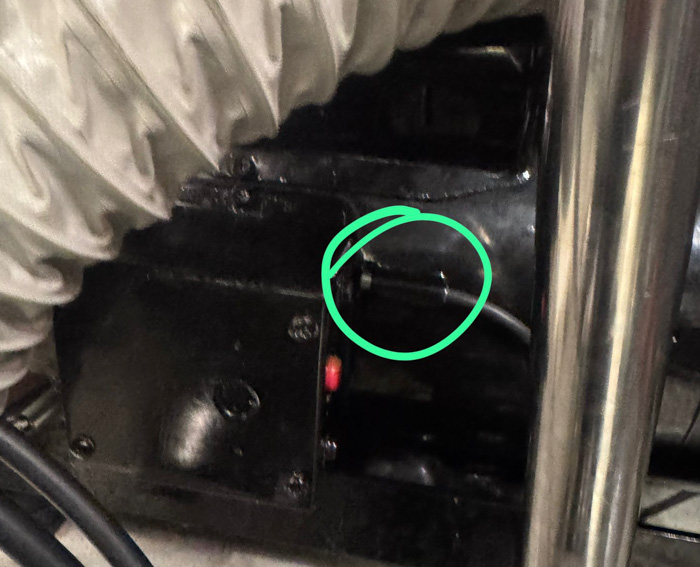
Additional analogue CZone interface
In order to gather all the analogue temperature readings, a new CZone interface will be installed which then only gives one value at a time into the NEMA 2k bus system. By this, the bus is not experiencing several new devices, which might overload the bus since I have so much date on it already, but, instead only sees one input device.
All the information can then be displayed in the NMEA 2000 Network.

.
New NMEA 2000 instrument
In order to display the above temperatures, including all other data on the NMEA bus, a new multi-talented display is installed over the companionway: the Maritron 4.1" display can literally show anything that is rushing by on on the NMEA 2000 but, something the Furuno displays actually can't.
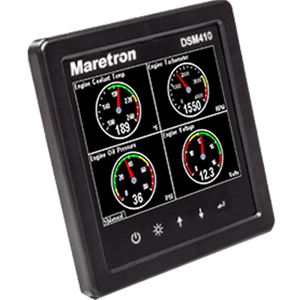
The display is placed to the right of the Furuno displays over the companionway, while the outsideloudspeaker will be replaced and situated elsewhere.

The new Maritron display to the right
.
VHF speaker
No new speaker was necessary since the outside remote ICOM control units have a very clear and loud speaker installed.
.
New main VHF
The VHF is one of the most important safety and communications devices onboard. That's why Regina Laska has no less than four VHF s onboard. One fixed with three terminal stations plus two Icom M25 handheld for everyday use and one GMDSS SOLAS approved VHF in the grab-bag by Jotron.
A huge wave came over the side on my last Atlantic sail from the Azores to Portugal when we deliberately chose to sail into a low to get good winds (see video here in German and with no spoken word). This wave made a short circuit in the VHF station at the steering helm, while the other stations were still fully functioning. I like 3 command stations for the main VHF, however (one at the pedestal, one under the hardtop and one at the navstation below). Instead of trying to repair the broken output channel, the 12 year old Furuno FM-4721 VHF is replaced by a new Icom 605.


The new VHF installed in Regina Laska
VHF's don't change much over the years, but this one is said to be made of a very high quality in Japan (manufactured not far from the Furuno factory, actually). The hardware is the same as the wheel-mark approved class A ICOM GM600, except that this non-SOLAS VHF is made for one antenna only (Class D).
One nice feature, maybe, is that you can just click on the MMSI-number directly on the AIS-display and call the other vessel via DSC (Digital Selective Calling) without having to call by voice-call or put in the MMSI number by hand.

For the pedestal at the steering helm plus under the Hardtop there are two HR 229B handheld command stations.
New Hailer and Fog Horn
I have been working with Italian Company Marco to improve their automatic control unit to better follow the Collision Regulation Rule 32 concerning sound signals. The approved fog horn EW2-M also has a hailer function with it's own dedicated microphone placed at the pedestal.

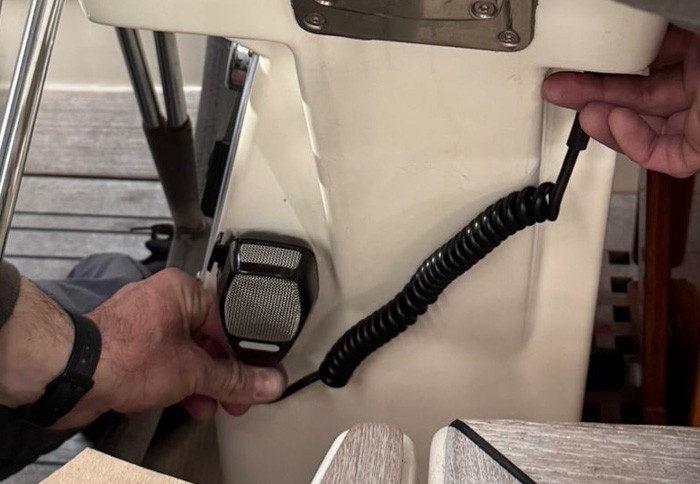
Raul experimenting where to place the microphone for the hailer.
.
The EW-2 is approved by RINA, LLOYD'S REGISTER MCA, BUREAU VERITAS, NMMA and BSH for vessels under 20m.
The sound signal itself (one long for power driven vessel and one long followed by two short ones for sailing vessel or vessel not under command) is controlled by CZone and can thus be controlled either by the navstation by means of two buttons or, alternatively, from under the hardtop on the Furuno plotter.
Of course, the fog horn also has a manual button situated at the pedestal, for auxiliary signals and which always overruns any automated signalling.

Since the foghorn is so large, it was moved to under the radar to be protected and not to interfere with the sails.
Cassens&Plath Compass
The new hand-crafted special Reginasailing compass, designed in co-operation with Cassens&Plath has been hand-crafted out of a solid brass housing with a white compass rose in Bremerhaven, Germany. I got this photo of the new Reginasailing compass from the workshop, ready to be shipped to Marina Coruña. At Cassens&Plath, in Bremerhaven, Germany, compasses are still made by hand, to the highest of standars and they have done so for over 120 years!
.
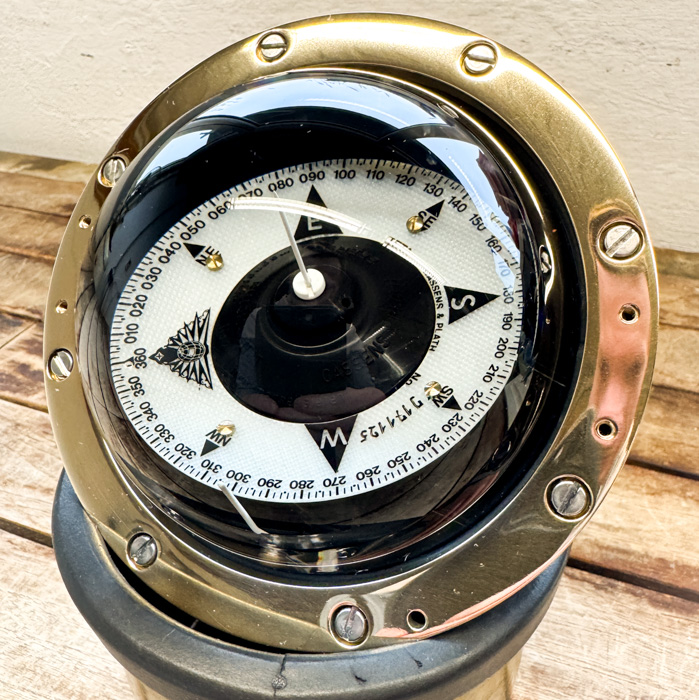
The specially built Reginasailing brass compass with a white compass rose and a central needle for celestial navigation to be installed on the pedestal. The white compass rose is essential for seeing the shade of the needle more easily.
Being a classic navigator, I love stylish, beautiful precision instruments that don't consume any power and accurately support terrestrial navigation. This model did not exist before with a solid brass housing combined with a white rose, which is so important when you check your compass by means of the shadow of the sun using the central vertical compass needle in celestial navigation. This is, for instance, extremely important when you have had a lighting strike (nearby). In such a case, it is very likely that not only all electronics are failing, but also that your compass has received an unknown deviation. In 60 miles, a deviation of no more than 5° means a full 5nm off track!
.
Besides, this compass becomes the jewellery of Regina Laska and pairs up so well with my equally beautiful Cassens&Plath Horizon Ultra sextant.
.
Most compasses today are unfortunately made of plastic. They might work, but where is the style?! If you ever have dreamt about a polished brass compass made for serious navigation, hurry up to order one before they all turn into plastic.... They are such an eye-catcher!
.
Sailing in Safety, Comfort and Style!
.

A white compass rose under production

These compasses are still hand-made out of brass by Cassens&Plath in Bremerhaven.
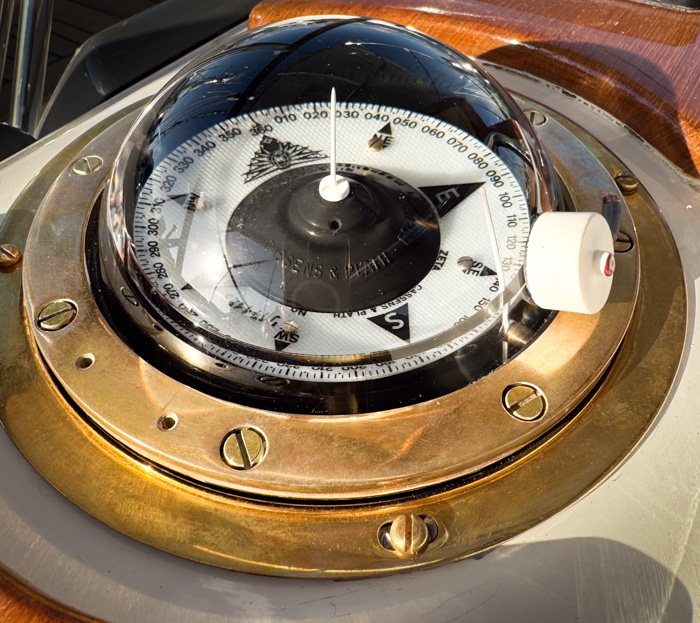
The Cassens&Plath compass installed on Regina Laska. The white button to the right is the compass light.
I have made a video how to calibrate the compass here.
h2a] Changing Voltage Stabiliser [/h2a]
A Voltage stabiliser is essential for a long life span of LED lights. Every electric motor, be it a water pump, an electric winch, the windlass or the bow thruster all give voltage spikes. They are not long (milliseconds), but enough for the life span to decrease. See my old video on the subject here.
For 12 years, I have had two 190W Voltage stabilisers from Whisperpower which have been working flawlessly, but they do have a built in fan that starts making noises. I have had these computer fans exchanged but they are still not 100% quiet.

My two Whisperpower 24/12-16i voltage stabilisers
Time to move on into the fan-less future with two Orion-Tr 24/12-20 240W voltage stabilisers by Victron.

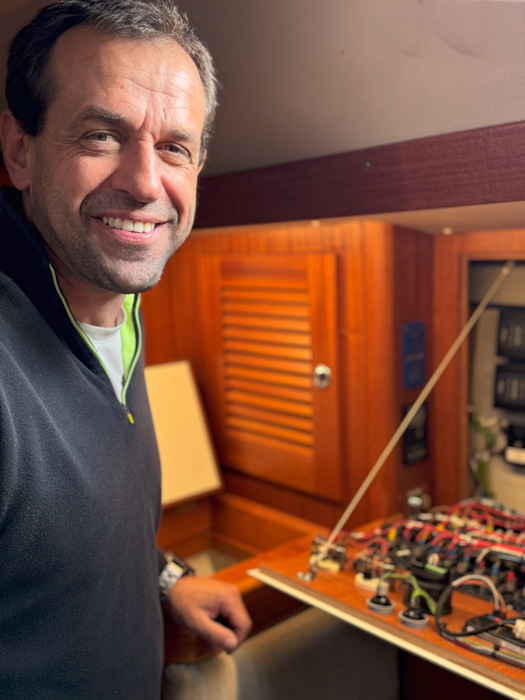
My favourite electrician Raul working on Regina Laska.
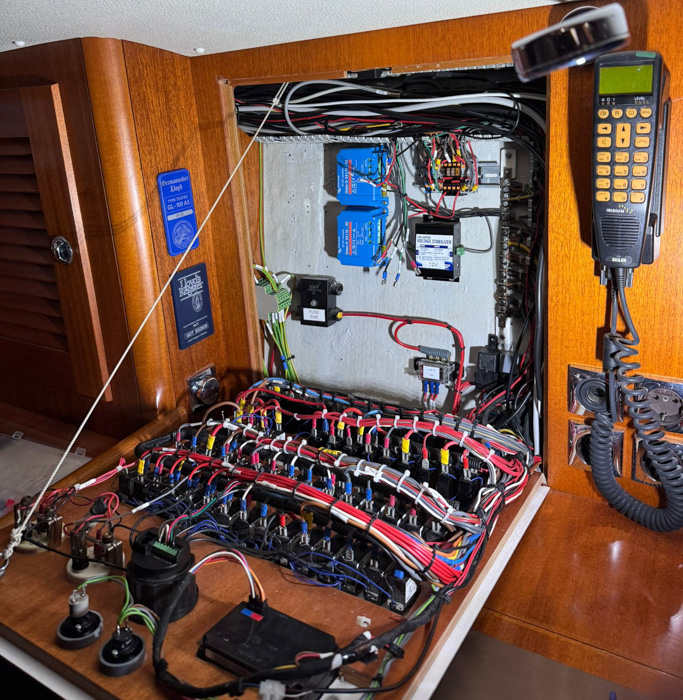
The two new voltage stabilisers are even much smaller than the old ones (Victron-blue)
.
Changing Nova to Stella lights
2025 Regina Laska will take a major step up when it comes to lighting. First up is the change of ceiling lights.
12 of the classic Nova ceiling lights are exchanged. Hundreds of thousand of these classic Nova lights made in Sweden have been installed in countless RV's and boats all over the world and has for decades been the standard in most boats. They are made out of plastic and despite being declared as not being water tight, I have been testing one and the same Nova light over my shower where warm moist vapour has reached the ceiling on a daily basis for 12 years, while sailing 6 months a year. This is impressive to say the least.

For 12 years, this Nova lamp has been tested in the harshest of environments despite even being declared as anything but an indoor light.

Testing various light option onboard Regina Laska. Here changing the old Nova with individually visual LED's (right) with the Stella Honeycomb (black hexagon web to the left). To my taste, the Honeycomb steal too much light so I chose the Stella Spot instead (not pictured here).
The light now feels a bit outdated with visible LED dots and giving no more than 145 lm of light with a 2W power consumption. It was time for something better!
Working jointly with Båtsystem these lights now have the very practical feature that they got the same outer diameter. In other words, they can easily be retrofitted in all boats which today are equipped with classic Nova-lights. Further, I requested a spotlight model which is tiltable. High Colour Rendering Index (CRI) and warm-white colour temperature was obviously also on the wish-list.
As the celestial navigator I am, I'm now proudly presenting Båtsystem's "Stella Series", fitting snugly into the holes of an old Nova, giving 200lm of light with the same power consumption of 2W, 25° of spot cone, tiltable to 90°, 3000K warm-white passive dimmable ceiling light. The are now also officially tested to IP65 watertightness. For elegancy, it's no longer made of plastic but stainless steel.

The new tiltable Båtsystem Stella Spot made in stainless steel giving 200lm of bundled light with no more than 2W of power consumption. CRI95 and 3000K.

One of the 13 new tiltable Stella Spot installed in the ceiling of Regina Laska.
13 of Regina Laska's Novas are replaced by Stella Spot and I'm just keeping my red/white Nova's for night sailing in the salon, run by my emergency secondary 12V power system. The red/white interchangable colour is the only feature Stella doesn't have, and nothing I really would miss. I prefer very dimmed down white lite to red bright light during night sailing. But possibly I might glance at the Prebit red/white EB12 for next year, who knows?
Upgrade to Prebit Wall Lights
A major step up is that the interior and outside light will be changed to Prebit. Prebit lights are made in Germany and are generally considered as the high end of interior lighting. They are installed on larger yachts, superyachts and also the high-end brands of middle sized yachts, such as Scalar, Sirius Yachts, Faurbu and, of course, Hallberg-Rassy. See some examples of Prebit lights installed in sailing yachts here.
It's time for Regina Laska to step into the elegant world of Prebit lights. The reason is that they produce elegant lights that are beautiful to look at.
During night time, you wish to be able to dim down the light all the way to candle-light strength and then, the lights should go down in light temperature from 3,000 Kelvin to some 2,200K in order to spread that cozy atmosphere.

The four wall lamps in the salon are being replaced by Prebit R1-1 in golden colour and chalk white shade.

The Prebit R1-1 in gold and chalk white pattern on the lamp shade.
The golden colour goes well with the brass instruments on the main bulkhead, such as the Chronometer, the Barometer, and inclinomete. The decoration should also work well with the golden tint: the Piraya fish, the wall paintings of northern Bohuslän, Valletta and Limburg (my three shore-based homes) as as well as Wagner's Rheingold plate with Alberich and the three Rheindaughters Wellgunde, Woglinde and Floßhilde illustrating my musical (but not political) favour for one of the greatest Opera composers (when it comes to the music).

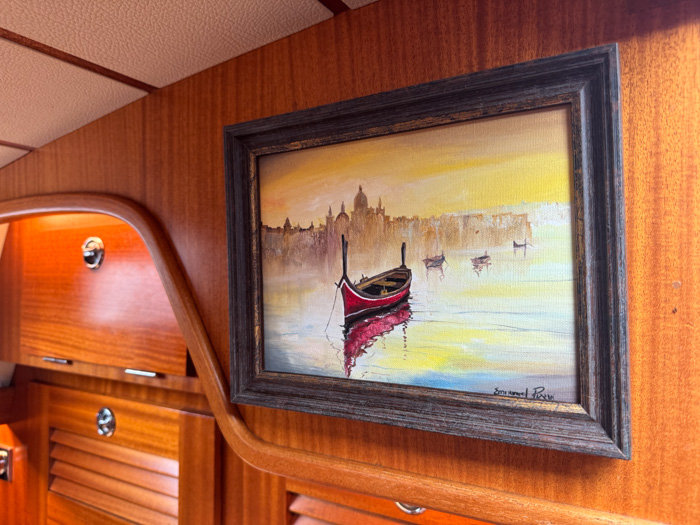




Read here, how I describe the way from oil lamp to a cozy wall lamp and why the new dim2warm® function by Prebit is so important for reading lights. Another important feature is that it can be dimmed down really much, which is essential for night sailing, something I have been lacking before.
The built-in USB charger is impressive! It gives up to 65W and automatically changes the voltage depending on the connected device and charging status, ranging from 5V all the way to 20V (if connected to 24V onboard power). This means that laptops can be connected directly to these lights!
.
New Stella Spot under the hardtop
The hardtop light also gets a good upgrade with three new lights.

First of all the old Båtsystem Neptun that sat under the hardtop have corroded (no blame, it's made for indoors and thus only IP21!). The three Power LED by CREE light source inside the light is still going strong, but the housing didn't survive the harsh outside environment which they never were made for.
The Neptun is thus replaced by a Stella Spot which is IP65 watertight, has also a spot function with a simliar beam width of 25° and will shine up the cockpit table when dimmed up and the cockpit floor during night sailing when dimmed down to almost nothing.

The spotlight shining onto the table at anchor so you can see what's on the table without getting the light into your eyes. The spot light is then "supported" by a cozy oil lamp and an original USB-chargable Poldina table lamp.
.
Two new Prebit EB42 under the hardtop

The old Båtsystem MARS with the switch sticking out (seen to the bottom right), where I often hurt my head under the hardtop, despite having cut if short with a side cutter.
Further to this central Stella Spot light, both current Båtsystem MARS flood-lights on either side under the hardtop are replaced. This time by beautiful Prebit EB42 lights. These Prebit lights are IP67 watertight, giving either white or red light for night sailing and have a built-in dimmer instead of the the metal switch where I hit my head so often. The Prebit EB42 has a CRI> 90 and shines with an impressive 780 lumen at max each, giving some 1600 lumen under the hardtop when needed (e.g. as extra deck light at anchor or in a marina). The previous Båtsystem MARS were neither watertight, nor do they shine in red and only give 150 lm each with a CRI of no more than 80.

Since it's watertight, it has its external watertight Prebit dimmer switch. of which there are three, one for each EB42 plus one for the new watertight outer nav-station light Flex05IP68 (see below).


Flood light under the hardtop under way (here only on for the photograph, otherwise it should be red or completely off, of course!)

The flood light at anchor, which now are 4 times as bright with the new Prebit-lights, when dimmed up completely.
New Prebit watertight nav-station light under the hardtop
A new watertight Flex05 iP68 with a black powder coating for extra robustness is installed on the starboard outside navstation.


It's great to have a watertight, dimmable light for the outside chart table, interchangeable between white and red light.

A Flex05 lamp for the outside chart table.
Changing the buttons for electric winches
The softer the electric outside button is to press, the less reliable it becomes, it seems. Therefore the push-buttons that are intended to be used by hand are sometimes getting stuck with the winch continuing to turn despite having released the button! This is dangerous!
One of the best buttons I have come across are the windlass buttons by MZ Electronics. They normally sit in the harsh environment on foredeck with loads of green water and still keep working correctly. I changed them on foredeck after may years of service and found no corrosion whatsoever (scroll down on the 11th refit here for new windlass buttons).
Being so content with the MZ Elecctronics buttons, the winch genoa and main sheet buttons will now also be exchanged to MZ buttons.

New anchor stopper
The anchor stopper I had installed in 2022 has some hazardous issues with possible hurting fingers, when closing the lid for the chain stopper. Further, the pin keeps wobbling out during harsh weather and big waves, and I had to fix it with a rubber cord and cable ties, which doesn't look that extremely smart and trustworthy.

The previous chain stopper by Lofrans that I have been using for two years.

The chain stopper by Quick that has an external lever so you can open an close the stopper from the outside so you don't hurt your fingers when closing the mechanism.

Quick chain stopper with it's lever clearly visible outside the chain mechanism, not to hurt fingers! I am looking forward to testing it!
At the same time, there is a stainless steel plate installed under the chain, so that the anchor cannot make a mark when the boat dives into big waves and the huge area of the anchor pushes the anchor up and thereby the shaft down onto the teak. If this is done long enough, the clutch on the windlass can loosen and the shaft may touch the teak. This happened during our last spring crossing of the bay of Biscay sailing days in a row against wind and waves, see short video here.
Fifth emergency bilge pump added
Regina Laska now has five emergency bilge pumps increasing the total capacity to close to 1,200 Liters/minute or close to 70 tones per hour if they are all running simultaneously. This is in best case, and there can always be a cause that one of the pumps don't work or the voltage in question is not available or one of the pumps are clogged up. Hence the redundancy.
The new Kärcher SP22.000 is originally designed to empty flooded ground floors or cellars, but can easily also be used as an efficient bilge pump if you have 230V onboard.

For redundancy purpose they run of different batteries and voltages as follows:
- 1 x manual Jabsco Amazon Warrior, 135 L/min, no electrical power needed
- 1 x Whale Gusher, 14L/min, running off 24V main batteries
- 1 x Rule 4000, 256 L/min, running off 24V main batteries
- 1 x Rule 4000, 256 L/min, running off 12V emergency battery system fed by 24V system, main engine and generator
- 1 x Ebara Best One 10,200L/h @ 1.5m, 170L/min @ 1.5m running off 230V system, fed by 24V (inverter) and 230V generator
- 1 x Kärcher SP 22.000 20,000L/h @ 1.5m , 333L/min @ 1.5m running off 230V system, fed by 24V (inverter) and 230V generator, new for 2025
Total: 1,164 L/min
.
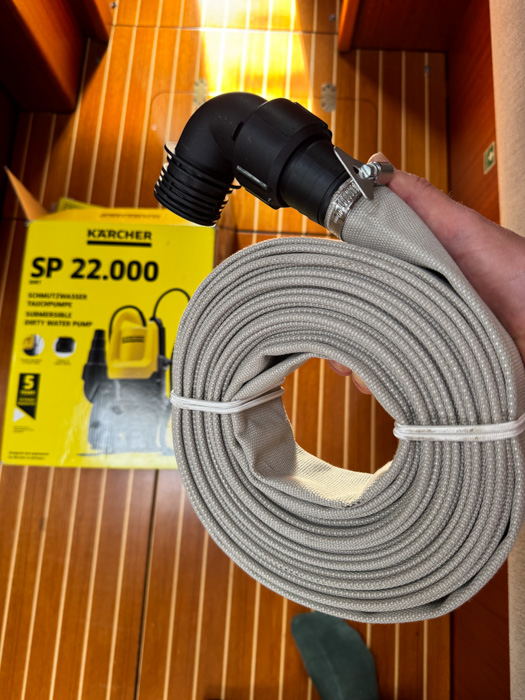
The water is pumped overboard by means of a fire hose.
.
No, I don't believe we will sink and it's maybe only a self-imposed psychological treatment against anxiety, but I would regret it a lot if, for some reason, the boat is taking in water and I could have saved her! The definition of floating is so easy:
"Floating is the state when you pump out more water than enters the boat!"
Interior cupboard door stoppers
During heavy seas, it's difficult to open a cupboard door to take out something from inside: with one hand you need to hold the cupboard door open and with the other hand you need to hold onto something yourself, so you don't fall over, but with which hand are you supposed to get to that snack inside? Also, they easily touch the wall lights, which needs to be stopped.

The door to the glass cabinet touching the light behind.

Therefore I have asked the yard for a solution of some sort to limit and door to how much it can open and also to remain in an open position while you are picking out something from the cupboard.

An idea of a door stopper
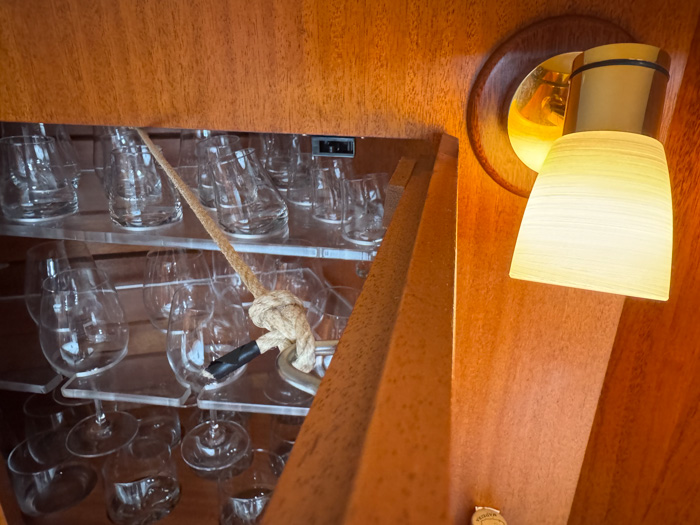
In the end, there was no time to shop for stoppers so it became the simple way with a nice, old-fashioned little line. It works, so we'll keep it like this for the time being.
New Nespresso machine
The new Nespresso CitiZ Platinum C Titan machine can not only do four types of coffee, including Americano and Americano XL for our American guests, but especially also hot water for tea. There is an extra little parallel pipe bypassing the coffee capsule compartment so that you can make tea by the press of a button and you don't have to even start the electric kettle!

New detergent and sponge holder
Even the smallest updates are sometimes worth mentioning and this one comes from one of my most frequent guests: Sibylle found this one for their own Hallberg-Rassy and the best feature is that it has a sump where water is collected at the bottom, anti-skit feet at the bottom. With a magnet (added by myself) it stays firmly against the wall, even in the biggest of waves. Before my previous holder was constantly gliding into the sink in big waves and left ugly dirt marks underneath.
I have fitted it with the same type of magnets as I used for the kettle bottom. See my video about it here.
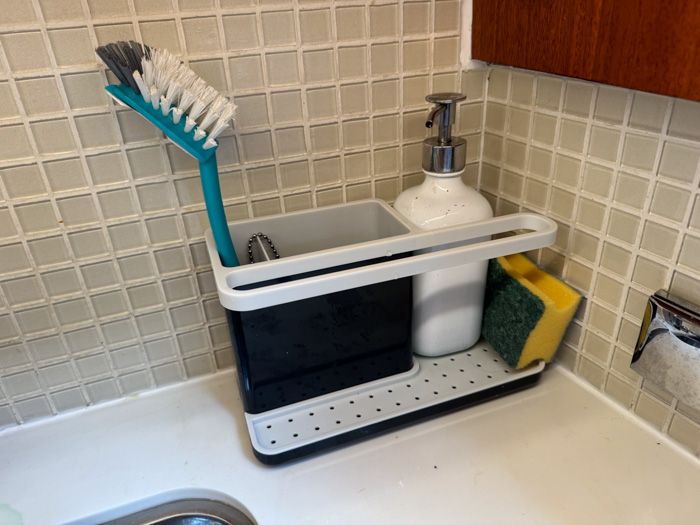
-
New vacuum cleaner
I didn't like Sir James Dyson speaking up clearly Pro-Brexit and then - just after the Prexiteers won - Dyson moved his company from the UK to Singapore.
This doesn't change the fact that bag-less cleaners are smart. Paper bag cleaners only have their maximum suction in the beginning with an empty bag and then get less efficient the fuller the bag gets. Bagless vacuum cleaner keep theyr efficiency util the bag is completely full.
There are bagless vacuum cleaners and there is the Dyson. I can just say how compact, efficient and practical the little V8 by Dysen is!

Vacuum cleaning my only little carpet these days....

Dysen also works wonders when cleaning the upholstery with "Vanish" and then vacuum cleaning with the rotating brushes of the Dyson V8.
And for all, who wonder: for the remaining floor I first vacuum clean with the Dyson (yes, it works on plain wood as well) and then I wipe off the wooden floor with my "Swiffer" which is so simple to use with its readily moist "tissues" you stick over the Swiffer.
And taken apart, t stows away extremely compact as well!


Starlink
Despite not being a fan of Elon Musk to say the least, I have finally given in and will install a Starlink system, despite not trusting Elon Musk for 5 minutes.
This is for my work with video conferencing, video-calls, youtube videos, Podcasts etc that I need a stable fast internet connection. The 5G or 4G cellphone coverage has just not been reliable enough at some anchorages. Also, it would be good to have access to good and detailed weather forecasting when crossing larger areas of ocean.

The new Reginasailing Starlink antenna being tested by Raul.
For important communication, however, I will keep my good old trusted Iridium phone, backed up by Garmin inReach and terrestrial SSB shortwave radio.
New Interior decoration
I got a nice little sailing boat made out of amber, bought at boot Düsseldorf. It got it's place next to the new Starlink Power switch and my world globe for circum-navigation.
New Harbour Manoeuvre Board Game
Sailpartner made a special Reginasailing harbour manoeuvre board for crew briefing and talking through various scenarios, playing with a HR46! So cool!
Solar Panels
I have been pondering about where to place solar panels for a long time now. I just don't fancy the look of a stern arch, despite it being highly practical, I an understand. Further, a HR46 should not carry too much weight at the stern since her narrow transom is not design to have too much weight in the back. It's heavy enough to have davits, an outboard on the pushpit two spare anchors in the huge aft deck locker together with lines and chemical liquids there. And on my hardtop I have my beautiful teak which I do not wish to cover with a solar panel.
I will start softly for 2025 and place them onto the Bimini.
For this reason, I have started a co-operation with Germany-based Solara, a specialist in solar panels for mobile use. I like the S525M32 Mobile fold-away solar panels which should be small and thin enough (685 x 628 x 25 mm) to fit down below when not in use (or so I hope). Unfolded, however, they fit to port and starboard of the window on the Bimini, increasing their surface to 1775 x 1020 x 16 mm.
The unfolded Solara Solar panels are place to the left and right of the center window on top of the bimini
The Solara solar panels are fitted with a number of Loxx buttons which will be supplied by Solara together with the solar panels (they supply complete systems for customers including fasteners) but can also be purchased loose, for instance from Gotthardt.
Replacing the earth plates
After 10 years of usage, the earth plates need to be replaced. They are simply clogged up due to fouling and other debris and don't offer the huge surface they are designed for.
Regina Laska has one earth plate for the instruments and three earth plates for the SSB radion that are now replaced.

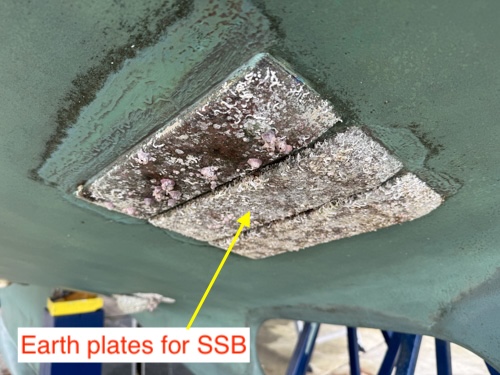
New horseshoe safety buoy
A new horseshoe buoy by Lalizas in a snug cover will replace the old one. Inside the cover of the "Quick RD" everything needed in a MOB situation is place outside of UV rays including safety line, light and the buoy itself.

Bathrooms polished
As in each year, both bathrooms are polished and refurbished for yet another sailing season in comfort and style.

All winches serviced
As in each year, all winches are taken apart and looked at and necessary parts are being exchanged. The new or cleaned parts are being greased and put together for yet another sailing season.







